Saturday: Wrocław
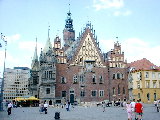


|
Our first stop in Poland, at Wrocław, found many impressive old buildings.
|
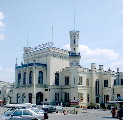

|
After a nice lunch in the Ratskeller, which claims to be the oldest restaurant in Europe, we returned to the castellated station to continue our journey.
|
Sunday: Katowice Tram Tour
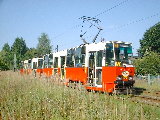
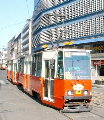
|
Left: Our chartered tram picked us up in the Rynek square in the centre of Katowice.
Right: And soon took us to more rural surroundings.
|


|
The tour visited two tram depots. Here you can see a snow sweeper at Będzin and an array of trams ready for service at Zychcice.
|
Mining Museum
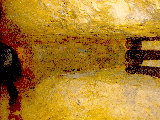
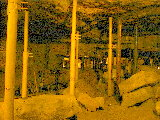
|
The Kopalnia Zabytkowa Rud Srebronosynch is a mining museum at Repty. The mine produced mainly zinc when it was operating. We had an interesting tour underground.
|

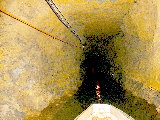
|
Left: Part of the tour was by rope-hauled boat along a flooded tunnel. How's that for a rare mode of transport!
Right: A miners' shrine, to Santa Barbera I think.
|
Chorzów Park
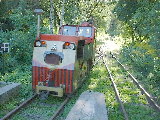
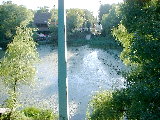

|
They say this enormous park is the largest city park in Europe, and second largest in the world after New York's Central Park. The park has a number of interesting attractions, including this 900mm gauge railway which is 5km long, and, to continue our collection of unusual transport modes, a horizontal chair lift system which runs through the tree-tops over lakes and gardens and even the zoo.
|
Katowice Depot
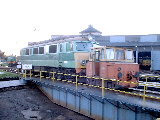

|
We ended the day with a visit in the evening light, to the railway depot at Katowice. Electric locomotives are moved on and off the turntable and into the roundhouses by a small battery-powered tractor.
|
Monday: Wieliczka Salt Mine
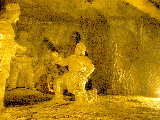
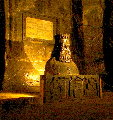
|
This salt mine has hundreds of kilometers of tunnels, of which tourists visit just a tiny fraction. The mine still produces salt by brine extraction, but the tunnels and chambers we visited are filled with sculptures carved in the rock salt. Photography was difficult in the low light but here's just a few shots.
Left: A bust of Casimir the Great, the king who granted the mining charter in 1368.
Right: Just a part of the collection of carvings in the Janowice Chamber, depicting the legend of how the salt came to be in this area.
|
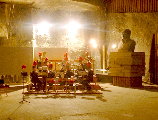
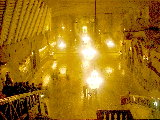
|
Left: St. Kinga's Chapel is the most spectacular chamber, 101 metres below ground. The reliefs on the walls, the altars and even the floor are carved from the rock salt.
Right: In another cavern we found this brass band, tucked into a corner and dwarfed by the 30 meter high cave.
Also in the mine was a large underground salt lake, spray chambers where the salt was mined using water jets leaving very strange rock formations, an auditorium with a capacity of 1,000 people, and some large caverns filled with complex timber structures to support the roof. We asked our guide how they know when they have to put timber supports into a chamber, but he didn't know!
|
Kraków

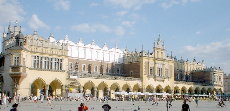
|
Next, a visit to the impressive city of Kraków, with its many historic buildings.
|


|
|
Tuesday: Maczki Bór "Sand Railway"

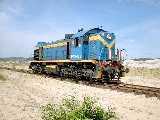
|
This is one of a number of "sand railways" in the Katowice area. They were originally constructed to carry sand from sand pits to coal mines where it is used to fill disused parts of the mine to prevent subsidence. That work continues, and the sand railways now also carry other freight, including coal and colliery waste from the mines.
Here are a couple of Maczki Bór's locos.
|
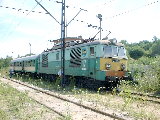
| For our visit they borrowed a passenger coach from Polish Railways so that we could have a tour of part their network. A much lighter load than usual for this electric locomotive.
|


| In the sand pit itself we saw these two giant extraction machines. A few of our party stood in front of one to give scale to the picture (right).
|

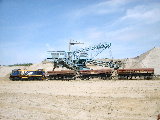
| A loco arrived with some empty wagons and the machine was fired up, soon filling them with sand - A most impressive operation. To save us walking back to our train, another loco arrived to give us a ride back. [Thanks to Richard Pegler of Along Different Lines for this picture.]
|
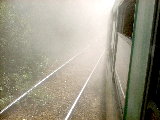
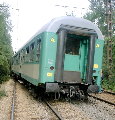

| We were continuing with our tour of the Maczki Bór system when suddenly the carriage lurched wildly and bumped to a stop in a cloud of dust. Once the dust settled we could see that the heat had caused the rails to buckle, de-railing our train. Needless to say, this was the end of our tour, so we walked down the line, across some sidings and up the embankment to a nearby road where we summoned our coach, to take us to the next destination. Fortunately nobody was injured in the incident.
|
Jaworzno Szczakowa
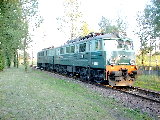
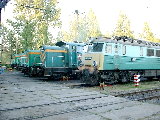
|
A visit to the railway depot at Jaworzno Szczakowa found a selection of locos, including this ET41 double unit (right). In common with many depots in this part of the world, it's very green, with lots of trees and grass between the lines.
|
Wednesday: Bytom
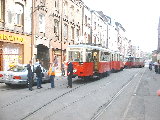
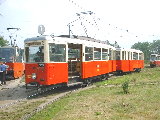
|
For our second tram tour of the week we took this preserved tram on a roundabout route to Bytom.
|
Górnoslaska Kolej Waskotorowa
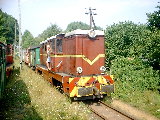
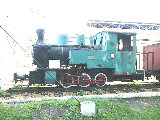
|
Next, we visited the Górnoslaska Kolej Waskotorowa narrow gauge railway, the remains of a network of hundreds of kilometers of 785mm gauge railway carrying freight and coal. It is now purely a tourist operation, and has been run by the local railway society since 2002. At Bytom Glówny station the narrow gauge line runs to a small platform at the back, where we found this non-operational steam loco, before joining our train hauled by an Lyd2 class diesel.
|
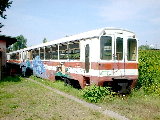
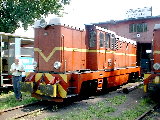
|
We stopped off to visit the railway's base at Bytom Karb.
|
Lasowice
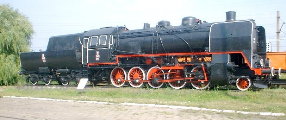
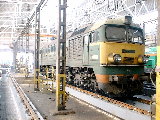

|
Further along the narrow gauge line we stopped to visit the main line depot at Lasowice. Like many railway depots they have a plinthed Kriegslok steam engine, but we also saw this much older Prussian loco (below, left) nearby. Inside the shed was a Russian-made diesel.
|
Thursday: Pyskowice

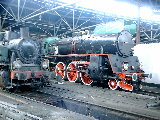
|
At Pyskowice we visited the steam locomotive restoration centre - Two roundhouses full of steam locos and other museum pieces, in various stages of restoration.
|
Rudy
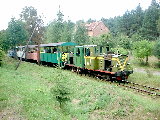

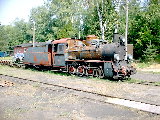
|
At this 785mm gauge tourist railway we had a ride behind a Tw53 class steam locomotive. We also used this pair of small diesels (right) for a ride along another branch.
I must include here a note of thanks to the gang at Along Different Lines, who did a great job of organising the Polish part of this holiday.
|
Friday: Dresden

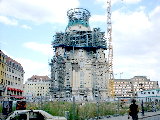



|
Our plan to visit another mining museum at Zarbze, near Katowice, on Friday morning was scuppered when we arrived at the door to find it wasn't open on bank holidays, so we pressed on across the border and into Germany, to Dresden.
There are some truly spectacular buildings in the city, although as you can see (top left) some more work is required on the restoration of the Frauenkirche - They hope to finish by 2006, the 800th anniversary of the city. (So it's just one year older than Liverpool.)
|
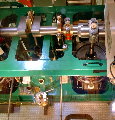
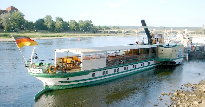
|
This splendid vessel is just one of a number of paddle-steamers which operate up and down the Elbe from Dresden. The engine was built in 1892 and is still going strong.
(The funnel has been lowered to pass under a low bridge.)
|


























































